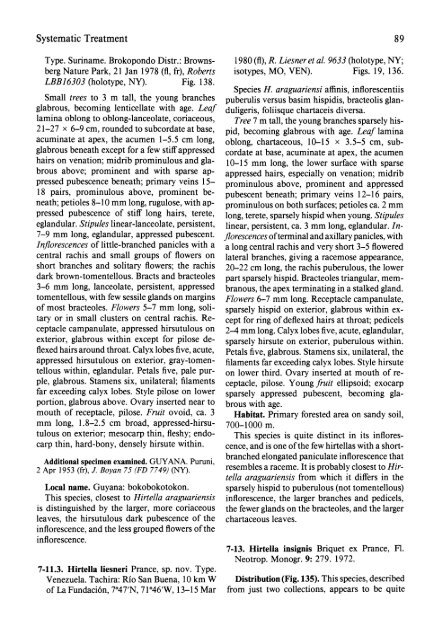flora neotropica - CNCFlora
flora neotropica - CNCFlora
flora neotropica - CNCFlora
Create successful ePaper yourself
Turn your PDF publications into a flip-book with our unique Google optimized e-Paper software.
Systematic Treatment 89<br />
Type. Suriname. Brokopondo Distr.: Browns-<br />
berg Nature Park, 21 Jan 1978 (fl, fr), Roberts<br />
LBB16303 (holotype, NY). Fig. 138.<br />
Local name. Guyana: bokobokotokon.<br />
This species, closest to Hirtella araguariensis<br />
is distinguished by the larger, more coriaceous<br />
leaves, the hirsutulous dark pubescence of the<br />
inflorescence, and the less grouped flowers of the<br />
inflorescence.<br />
7-11.3. Hirtella liesneri Prance, sp. nov. Type.<br />
Venezuela. Tachira: Rio San Buena, 10 km W<br />
of La Fundaci6n, 7?47'N, 71046'W, 13-15 Mar<br />
1980 (fl), R. Liesner et al. 9633 (holotype, NY;<br />
isotypes, MO, VEN). Figs. 19, 136.<br />
Species H. araguariensi affinis, inflorescentiis<br />
Small trees to 3 m tall, the young branches puberulis versus basim hispidis, bracteolis glanglabrous,<br />
becoming lenticellate with age. Leaf duligeris, foliisque chartaceis diversa.<br />
lamina oblong to oblong-lanceolate, coriaceous, Tree 7 m tall, the young branches sparsely his-<br />
21-27 x 6-9 cm, rounded to subcordate at base, pid, becoming glabrous with age. Leaf lamina<br />
acuminate at apex, the acumen 1-5.5 cm long, oblong, chartaceous, 10-15 x 3.5-5 cm, subglabrous<br />
beneath except for a few stiff appressed cordate at base, acuminate at apex, the acumen<br />
hairs on venation; midrib prominulous and gla- 10-15 mm long, the lower surface with sparse<br />
brous above; prominent and with sparse ap- appressed hairs, especially on venation; midrib<br />
pressed pubescence beneath; primary veins 15- prominulous above, prominent and appressed<br />
18 pairs, prominulous above, prominent be- pubescent beneath; primary veins 12-16 pairs,<br />
neath; petioles 8-10 mm long, rugulose, with ap- prominulous on both surfaces; petioles ca. 2 mm<br />
pressed pubescence of stiff long hairs, terete, long, terete, sparsely hispid when young. Stipules<br />
eglandular. Stipules linear-lanceolate, persistent, linear, persistent, ca. 3 mm long, eglandular. In-<br />
7-9 mm long, eglandular, appressed pubescent. florescences ofterminal and axillary panicles, with<br />
Inflorescences of little-branched panicles with a a long central rachis and very short 3-5 flowered<br />
central rachis and small groups of flowers on lateral branches, giving a racemose appearance,<br />
short branches and solitary flowers; the rachis 20-22 cm long, the rachis puberulous, the lower<br />
dark brown-tomentellous. Bracts and bracteoles part sparsely hispid. Bracteoles triangular, mem-<br />
3-6 mm long, lanceolate, persistent, appressed branous, the apex terminating in a stalked gland.<br />
tomentellous, with few sessile glands on margins Flowers 6-7 mm long. Receptacle campanulate,<br />
of most bracteoles. Flowers 5-7 mm long, soli- sparsely hispid on exterior, glabrous within extary<br />
or in small clusters on central rachis. Re- cept for ring of deflexed hairs at throat; pedicels<br />
ceptacle campanulate, appressed hirsutulous on 2-4 mm long. Calyx lobes five, acute, eglandular,<br />
exterior, glabrous within except for pilose de- sparsely hirsute on exterior, puberulous within.<br />
flexed hairs around throat. Calyx lobes five, acute, Petals five, glabrous. Stamens six, unilateral, the<br />
appressed hirsutulous on exterior, gray-tomen- filaments far exceeding calyx lobes. Style hirsute<br />
tellous within, eglandular. Petals five, pale pur- on lower third. Ovary inserted at mouth of reple,<br />
glabrous. Stamens six, unilateral; filaments ceptacle, pilose. Young fruit ellipsoid; exocarp<br />
far exceeding calyx lobes. Style pilose on lower<br />
sparsely appressed pubescent, becoming glaportion,<br />
glabrous above. Ovary inserted near to brous with age.<br />
mouth of receptacle, pilose. Fruit ovoid, ca. 3 Habitat. Primary forested area on sandy soil,<br />
mm long, 1.8-2.5 cm broad, appressed-hirsu- 700-1000 m.<br />
tulous on exterior; mesocarp thin, fleshy; endo- This species is quite distinct in its inflorescarp<br />
thin, hard-bony, densely hirsute within. cence, and is one of the few hirtellas with a shortbranched<br />
Additional specimen examined. GUYANA. Puruni,<br />
elongated paniculate inflorescence that<br />
2 Apr 1953 (fr), J. Boyan 75 (FD 7749) (NY).<br />
resembles a raceme. It is probably closest to Hirtella<br />
araguariensis from which it differs in the<br />
sparsely hispid to puberulous (not tomentellous)<br />
inflorescence, the larger branches and pedicels,<br />
the fewer glands on the bracteoles, and the larger<br />
chartaceous leaves.<br />
7-13. Hirtella insignis Briquet ex Prance, Fl.<br />
Neotrop. Monogr. 9: 279. 1972.<br />
Distribution<br />
(Fig. 135). This species, described<br />
from just two collections, appears to be quite

















